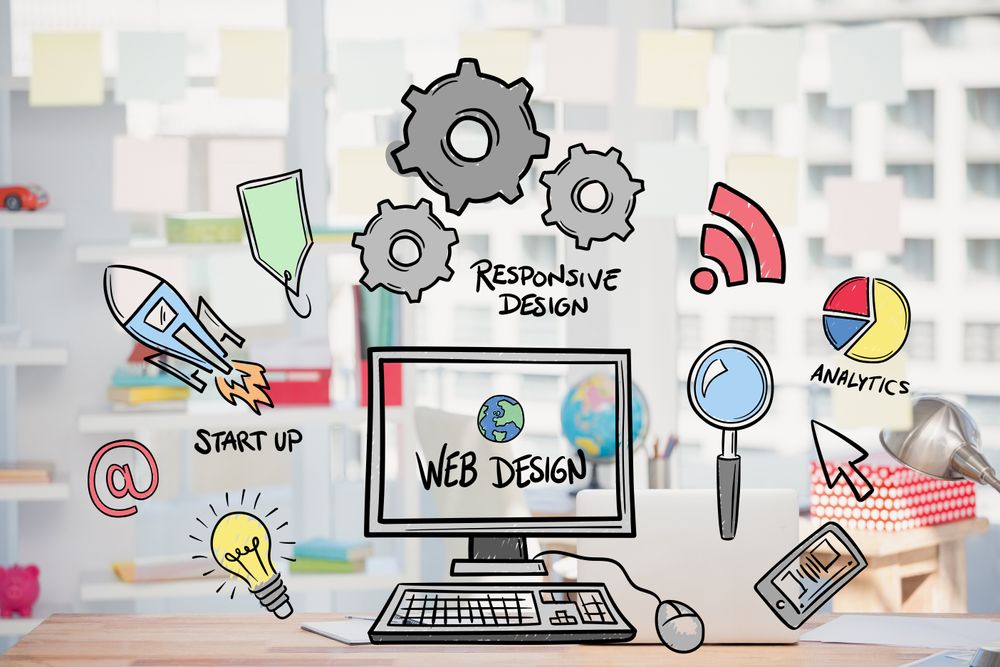Local Web Designer Jacksonville Fl: Crafting Effective Websites Needs Careful Preparation And Execution
Interface (UI) and User Experience (UX): The Heart of Web Design
Ever arrived at a site and immediately knew where to click? That's great UX whispering in your ear. Alternatively, keep in mind a time when you were utterly lost, clicking aimlessly? UI design failed, my pal. In website design, UI and UX are like two sides of the very same coin. One focuses on aesthetic appeals and interactivity (UI), while the other dives into the user's sensations and journey (UX) Believe of it as the Yin and Yang of the digital world.
UI: The Art of the Interface
Interface (UI) design is everything about the visual elements individuals interact with. It's the buttons, icons, typography, color combinations, and total design that welcomes the user. A properly designed UI is aesthetically pleasing, intuitive, and constant. Consider websites with clear call-to-action buttons versus those buried in a complicated mess. Which one are you most likely to engage with? Reliable UI design improves brand name perception and guides users seamlessly through a website.
UX: Comprehending the User's Journey
User Experience (UX) design, on the other hand, is about comprehending the user's requirements, goals, and pain points. It encompasses the entire process a user goes through when engaging with a website, from initial discovery to last conversion. It includes user research, creating user personas, wireframing, and use testing. A great UX designer expects user needs and develops a friction-free experience. Have you ever abandoned a shopping cart because the checkout procedure was too complicated? That's a UX issue.
Why UI/UX Matters
- Increased Engagement: A properly designed UI/UX keeps users on your site longer.
- Higher Conversion Rates: User-friendly design leads to more sales and conversions.
- Improved Brand Loyalty: Positive experiences construct trust and encourage repeat sees.
- Lowered Bounce Rates: Users are less most likely to leave a website that is simple to navigate.
Key Principles of UI/UX Style
So, what makes for strong UI/UX in website design? It boils down to a few core principles:
- Use: Is the site easy to use and navigate?
- Availability: Is the website available to users with impairments?
- Desirability: Is the site aesthetically appealing and appealing?
- Value: Does the site offer worth to the user?
- Clarity: Is the information provided clearly and concisely?
Ultimately, successful web style depends upon the thoughtful combination of UI and UX principles. It has to do with creating sites that are not just gorgeous but also functional and user-centered. Disregarding either one can lead to an aggravating user experience and, eventually, a lost chance. Who wants to visit a digital ghost town?
Web Design Principles: Structures for Success
Ever feel like you're shouting into the space with your site? A site that looks pretty however doesn't, well, work? It's a common concern. You've got an excellent product, stellar content, however something's wrong. Frequently, the perpetrator isn't the what, however the how-- the underlying web style concepts. It has to do with crafting an intuitive, interesting experience that whispers, "Welcome, begun in."
The Core Tenets
Think about these as the principles, the secret sauce. Disregarding them is like constructing a house on sand.
- Use: Can visitors quickly find what they need? Navigation must be crystal clear.
- Ease of access: Is your site usable by everyone, consisting of those with specials needs? Alt text on images, correct color contrast-- these aren't simply nice-to-haves, they're vital.
- Visual Hierarchy: What do you desire people to see? Usage size, color, and positioning to guide the eye.
- Consistency: A consistent design develops trust. Use the very same fonts, colors, and styles throughout your website.
- Responsiveness: Does your site look good on all devices? Mobile-first is no longer a pattern; it's the requirement.
Navigating the Difficult Bits
Here's where things frequently go sideways: information architecture. Imagine a library with books spread randomly. Discouraging, ideal? Your website is the exact same. Plan your website structure thoroughly. Usage card arranging exercises to comprehend how users categorize info. Do not bury important content numerous clicks deep. The less clicks, the much better.
And then there's the "curse of knowledge." You understand your service inside and out. But your visitors don't. Prevent lingo. Compose in plain language. Evaluate your material with real users who aren't knowledgeable about your market. Their confusion is your roadmap to improvement.
A key factor to consider often ignored is web browser compatibility. Even if your site looks perfect in Chrome doesn't imply it will in Firefox or Safari. Cross-browser testing is vital. Use tools like BrowserStack or LambdaTest to guarantee a constant experience for all users.
Another prospective failure is overlooking the mobile experience. With most of web traffic now coming from mobile phones, a mobile-unfriendly site is a death knell. Mobile-first design is vital. Focus on material and features for smaller screens. Usage responsive images and optimize filling times.
Eventually, reliable web design isn't about aesthetics alone. It has to do with comprehending your audience, expecting their requirements, and developing a seamless, instinctive experience. When you get the concepts right, the results promote themselves.
Web Development Technologies and Languages: The Engine Under the Hood
You've thoroughly crafted a sensational web style, a visual work of art ready to wow the world. But what breathes life into that fixed image? What translates your innovative vision into a functional, interactive website experience? The answer lies in web advancement innovations and languages. Think about it as the engine room of your website, the complex machinery that powers whatever from user interactions to data processing.
Selecting the Right Tools: A Designer's Dilemma
Selecting the ideal innovations belongs to picking the perfect set of tools for a craftsman. The possibilities are endless, each with its own strengths and weaknesses. JavaScript, for circumstances, is the indisputable king of front-end interactivity, permitting you to develop dynamic components, animations, and smooth user experiences. But what about the back-end, the server-side reasoning that handles information storage, user authentication, and all the behind-the-scenes operations? Do you choose the sophistication of Python with its structures like Django or Flask? Or possibly the raw power of Node.js, making it possible for JavaScript to run on the server?

And after that there's the database-- the repository of all your website's details. Will you select a relational database like MySQL or PostgreSQL, known for their structured information management? Or possibly a NoSQL database like MongoDB, providing higher flexibility and scalability for managing unstructured information? The choices can be frustrating, resulting in a typical barrier: analysis paralysis.
- HTML/CSS: The foundational foundation for structuring and styling your content.
- JavaScript: The language of interactivity, bringing your site to life.
- Python: A versatile language often used for back-end advancement and data analysis.
- PHP: An extensively utilized server-side scripting language.
- Databases (MySQL, MongoDB): Where your website's data lives.
The Risks of Ignoring Performance
Picture constructing a magnificent skyscraper on a shaky structure. Picking ineffective innovations or disregarding performance optimization can lead to a sluggish, unresponsive site, driving users away in droves. A typical oversight is stopping working to enhance images, resulting in puffed up page sizes and glacial packing times. Another is composing inefficient code that consumes extreme server resources.
A skilled web designer comprehends the significance of code splitting, lazy loading, and caching strategies to ensure a snappy, responsive user experience. They also understand how to profile their code to identify and eliminate efficiency bottlenecks. They are believing about the website efficiency.
Here's a little trick: Regularly investigate your website's performance using tools like Google PageSpeed Insights or WebPageTest. These tools offer vital insights into locations for enhancement, helping you recognize and deal with efficiency bottlenecks before they affect your users.
Beyond the Code: Embracing the Environment
Web development is more than just composing code; it has to do with welcoming the entire environment of tools, libraries, and frameworks that can improve your workflow and improve your efficiency. Plan supervisors like npm or yarn allow you to easily set up and manage dependences, while task runners like Gulp or Grunt automate recurring tasks. Variation control systems like Git are important for cooperation and tracking changes to your codebase. Ignoring these tools is akin to attempting to construct a home with just a hammer and nails.
The world of web development is continuously developing, so continuous learning is important. Embrace the uncertainty, explore new technologies, and never ever stop sharpening your skills. After all, the best web designers are those who are constantly pushing the boundaries of what's possible.
Mobile-First and Responsive Web Style: Beyond the Breakpoint
Ever squint at a website on your phone, pinching and zooming simply to check out a paragraph? That's the reverse of mobile-first style. It's not merely about diminishing a desktop website; it's an essential shift. We begin with the smallest screen, the most constrained environment, and then gradually boost for bigger displays. Why? Because a mobile user's attention span is short lived, their perseverance razor-thin. If your site doesn't provide, they're gone. Think about it as distilling the essence of your message, and after that adding embellishments for those with the high-end of a larger screen and more time.
The Pitfalls of Desktop-First Thinking
The old mindset, desktop-first, often causes puffed up designs packed with unnecessary aspects. These aspects then get clumsily shoehorned onto mobile, leading to a discouraging user experience. Ask yourself: are those elegant animations truly including worth, or are they simply slowing down the load time on a 3G connection? Mobile-first forces you to prioritize. It requires ruthless efficiency.
- Prioritize Core Content: Identify the most crucial information and features.
- Improve Navigation: Make it simple for users to find what they need.
- Optimize Images: Compress images to decrease file size without compromising quality.
The Responsive Web Design Benefit
Responsive design is the strategy that makes mobile-first a truth. It's the art of crafting sites that adjust effortlessly to any screen size, utilizing fluid grids, versatile images, and media queries. Ever question how some sites amazingly resize themselves when you switch from landscape to portrait mode on your tablet? That's responsive design in action. However it's not almost resizing; it has to do with re-organizing, re-prioritizing, and re-imagining the user interface to match the device.
Preventing Typical Stumbling Blocks
One regular bad move is disregarding touch targets. Those tiny links and buttons that are perfectly clickable with a mouse become an aggravating obstacle course for fingers. Another is assuming all mobile users are on fast Wi-Fi. Optimize, enhance, enhance! Every kilobyte counts. And do not forget availability. A mobile-first technique, done right, can actually improve ease of access for all users, regardless of device or capability. Are you checking your designs on real mobile devices, or simply relying on internet browser emulators? There's a world of distinction between theory and reality. Website design requires extensive screening.
Beyond Resolution: Context Matters
It's not almost screen size; it's about user context. A user browsing on their phone during their commute has various needs and expectations than someone sitting at a desktop in their workplace. Mobile users are typically trying to find quick answers, directions, or instant action. Your design needs to show this seriousness. User experience is critical. Are you developing for the moment, or just for the screen? In the end, mobile-first and responsive design aren't just patterns; they're vital for survival in today's digital landscape. They are web design.
Jacksonville, FL Website Design Provider
Jacksonville, Florida, a lively city with a growing population, uses a blend of coastal appeal and city features. Known for its beautiful beaches, comprehensive park system, and prospering arts scene, Jacksonville is a popular destination for both residents and visitors. The city boasts a diverse economy, with essential sectors consisting of finance, healthcare, logistics, and advanced manufacturing.
If you're wanting to improve your online existence, Fisher Agency can assist. They offer expert suggestions and guidance on web design to assist you accomplish your company objectives. Contact them for a totally free consultation and find how they can change your digital method.
 Ralph Macchio Then & Now!
Ralph Macchio Then & Now! Anna Chlumsky Then & Now!
Anna Chlumsky Then & Now! Jurnee Smollett Then & Now!
Jurnee Smollett Then & Now! Elisabeth Shue Then & Now!
Elisabeth Shue Then & Now! Melissa Sue Anderson Then & Now!
Melissa Sue Anderson Then & Now!